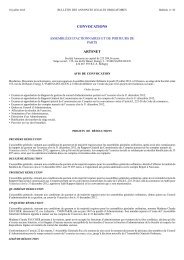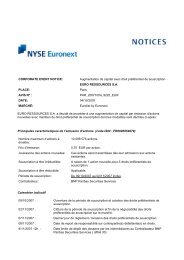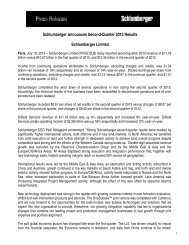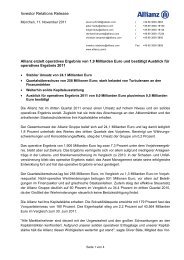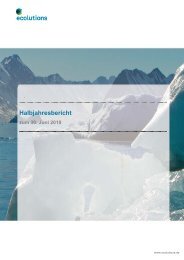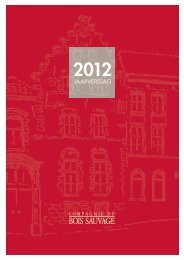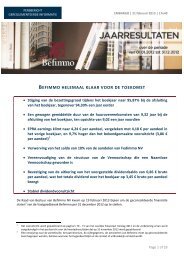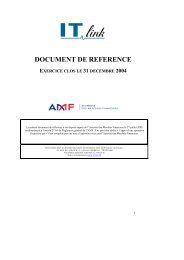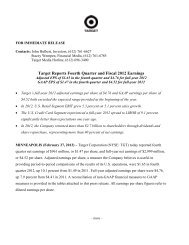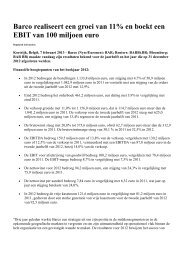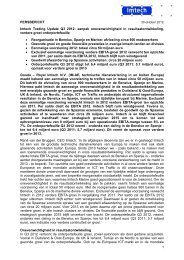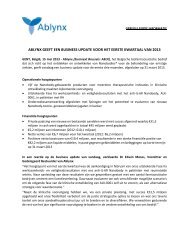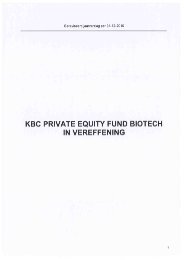FORM 10-Q
FORM 10-Q
FORM 10-Q
Create successful ePaper yourself
Turn your PDF publications into a flip-book with our unique Google optimized e-Paper software.
Credit Risk Associated with Derivatives<br />
We have established strict counterparty credit guidelines and enter into transactions only with financial institutions of investment grade or better. We monitor<br />
counterparty exposures regularly and review any downgrade in credit rating immediately. If a downgrade in the credit rating of a counterparty were to occur, we<br />
have provisions requiring collateral in the form of U.S. government securities for substantially all of our transactions. To mitigate presettlement risk,<br />
minimum credit standards become more stringent as the duration of the derivative financial instrument increases. In addition, the Company's master netting<br />
agreements reduce credit risk by permitting the Company to net settle for transactions with the same counterparty. To minimize the concentration of credit risk,<br />
we enter into derivative transactions with a portfolio of financial institutions. Based on these factors, we consider the risk of counterparty default to be<br />
minimal.<br />
Cash Flow Hedging Strategy<br />
The Company uses cash flow hedges to minimize the variability in cash flows of assets or liabilities or forecasted transactions caused by fluctuations in<br />
foreign currency exchange rates, commodity prices or interest rates. The changes in the fair values of derivatives designated as cash flow hedges are recorded<br />
in AOCI and are reclassified into the line item in our condensed consolidated statements of income in which the hedged items are recorded in the same period<br />
the hedged items affect earnings. The changes in fair values of hedges that are determined to be ineffective are immediately reclassified from AOCI into<br />
earnings. The Company did not discontinue any cash flow hedging relationships during the three months ended March 29, 2013, or March 30, 2012. The<br />
maximum length of time for which the Company hedges its exposure to future cash flows is typically three years.<br />
The Company maintains a foreign currency cash flow hedging program to reduce the risk that our eventual U.S. dollar net cash inflows from sales outside the<br />
United States and U.S. dollar net cash outflows from procurement activities will be adversely affected by fluctuations in foreign currency exchange rates. We<br />
enter into forward contracts and purchase foreign currency options (principally euros and Japanese yen) and collars to hedge certain portions of forecasted<br />
cash flows denominated in foreign currencies. When the U.S. dollar strengthens against the foreign currencies, the decline in the present value of future foreign<br />
currency cash flows is partially offset by gains in the fair value of the derivative instruments. Conversely, when the U.S. dollar weakens, the increase in the<br />
present value of future foreign currency cash flows is partially offset by losses in the fair value of the derivative instruments. The total notional values of<br />
derivatives that were designated and qualified for the Company's foreign currency cash flow hedging program were $ 5,327 million and $4,715 million as of<br />
March 29, 2013, and December 31, 2012, respectively.<br />
The Company has entered into commodity futures contracts and other derivative instruments on various commodities to mitigate the price risk associated with<br />
forecasted purchases of materials used in our manufacturing process. These derivative instruments have been designated and qualify as part of the<br />
Company's commodity cash flow hedging program. The objective of this hedging program is to reduce the variability of cash flows associated with future<br />
purchases of certain commodities. The total notional values of derivatives that were designated and qualified for the Company's commodity cash flow hedging<br />
program were $12 million and $17 million as of March 29, 2013, and December 31, 2012, respectively.<br />
Our Company monitors our mix of short-term debt and long-term debt regularly. From time to time, we manage our risk to interest rate fluctuations through the<br />
use of derivative financial instruments. The Company has entered into interest rate swap agreements and has designated these instruments as part of the<br />
Company's interest rate cash flow hedging program. The objective of this hedging program is to mitigate the risk of adverse changes in benchmark interest<br />
rates on the Company's future interest payments. The total notional values of these interest rate swap agreements that were designated and qualified for the<br />
Company's interest rate cash flow hedging program were $ 2,215 million and $1,764 million as of March 29, 2013, and December 31, 2012, respectively.<br />
12



